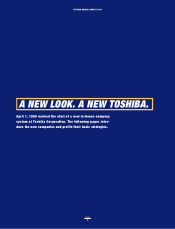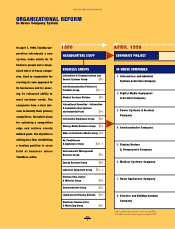Toshiba 1999 Annual Report Download - page 19
Download and view the complete annual report
Please find page 19 of the 1999 Toshiba annual report below. You can navigate through the pages in the report by either clicking on the pages listed below, or by using the keyword search tool below to find specific information within the annual report.
TOSHIBA ANNUAL REPORT 1999
Page
17.
SRAMs and flash memories, particularly
SmartMedia, the high-capacity data storage
medium based on NAND flash memory
pioneered by Toshiba. It is already the de
facto standard storage device for digital
still cameras, and will get a further boost
in summer 1999, when the company
commercializes a 64 megabyte SmartMedia
card that will double the current capacity.
SmartMedia is highly versatile and is
expected to find expanded applications in
such areas as recording music.
In terms of overall business structure,
the Semiconductor Company is shifting to
logic devices and system LSIs, where
growth is higher than in the overall semi-
conductor market. By fiscal 2001, Toshiba
aims for these products to account for at
least 50% of the value of total semicon-
ductor sales. As part of this drive, a joint-
venture company was formed in June 1999
with Sony Computer Entertainment Inc.,
which holds the overwhelming share of
the world’s home game console market.
This new company will develop, manufac-
ture and supply the high-speed CPU for
Sony’s next-generation game console.
Beyond this, Toshiba intends to position
its TX System RISC, based on the archi-
tecture of MIPS Technologies, Inc., as the
main processor for such applications as
networking and digital home appliances.
Toshiba also intends to reinforce its
position in the discrete semiconductor
business. This business generates stable
earnings and is an area where Toshiba
holds the number one share worldwide.
In R&D, Toshiba aims to share devel-
opment costs with other companies and
shorten the time taken to bring new prod-
ucts to market. In this vein, Toshiba
started joint development with Fujitsu
Limited in December 1998 of 0.13-micron
process technology for 1-gigabit DRAM
class devices. Toshiba is also restructuring
its worldwide network of production bases
from a global perspective in an effort to
improve efficiency.
generate stable revenues and bolster cost
competitiveness.
In the price-competitive memory mar-
ket, Toshiba is redirecting its attention to
building a strong presence in products
offering higher profitability. While
Toshiba leads in high-speed synchronous
DRAM and RambusTM DRAM, it is also
expanding into non-PC markets, such as
those for mobile communications and net-
working. Joint development of Fast Cycle
RAM (FCRAM) with Fujitsu Limited is
part of this endeavor.
In addition to these moves, Toshiba will
promote development of a business model
that is largely shielded from market
cycles, raising the share of memory prod-
ucts other than DRAM in order to boost
profitability. The prime drivers here are
Hopes are high for SmartMedia, a
de facto standard for digital still
picture storage, to also find ap-
plications in the recording of mu-
sic and other types of content.
Toshiba teamed
up with Sony Com-
puter Entertainment
to develop the 128-
bit high-speed CPU
for that company’s
next-generation
home game console.
























